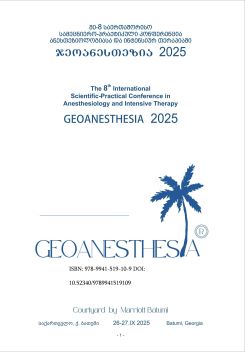Cytoprotectors and Pharmacological Antagonists in Medical Toxicology
DOI:
https://doi.org/10.52340/9789941519109.15Abstract
Background. Investigation of positive and negative co-transmission may give the way for new pharmacological approachers in treatment of acute poisonings by drugs. Aim. Investigation of cytoprotectors and pharmacological antagonists in acute severe poisonings by CNS acting poisons (clonidine, galoperidol, C0, and heroin withdrawal [HW]). Setting. SPB Alexander City Hospital, Los Angeles Marine Hospital (S-L Project), SPB Poison Treatment Center (PTC). 348 poisoned patients admitted to medical facilities listed above for the period of 15 years (post marketing investigations). Interventions and Measurements. Consciousness, arousal, orientation (by Glasgow Coma Score [GCS]), duration of coma, and stay in ICU; hemodynamic measurements done by cuff method, and rheoanalyser PA-05; extrapyramidal syndrome (ES) measured by electrical impedance myography on polygraph PG-01; endogenous intoxication (EI) during HW by Malachova method, verification of poisoning were done by semiquantative methods. Investigated medications included: Cytoflavin (Inosine + Nicotinamide + Riboflavin + Succinic Acid), cholinergic enhancer choline alfoscerate (gliatilline), adenosine (A), metoclopramide (M), cytoflavine (C), ondansetron (O), foridon (F). Records were done in toxicogenic and somatogenic phases of poisonings. Statistics were made by Wilcoxon-Manna-Witny “U” test (p=0,05).
Results. In clonidine poisonings awakening effect was investigated (n=52): O (IV 0,03 bolus+ 0,09 mg/kg maintenance) and M (IV 0,5 bolus+ 0,25 mg/kg maintenance), but not D, or At increased GCS from 10,8±0,03 to 13,6±0,2 (p=0,05) and 12,3±0,06 (=0,01), correspondently. Duration of awakening effect of M and O was 140±3,5 and 270±5,3 correspondently (p<0,05).
In galoperodol poisonings severity and prolongation of ES was investigated (n=22): A (10 mg/kg bolus + maintenance), but not D (0,14 mg/kg), or CD (1 mg/70 kg b.w) decreased extrapyramidal exacerbations 1,2 times more then D and CD, follow up by reduction of lactate blood concentration. In HW the combination of F+M+A and C decreased EI twice more than in controls, follow up by the reduction of buprenorphine suppressive dose. Length of stay in ICU was 1,5 less than in the controls. In C0 poisoning C and Ml administration increased cognitive functions by MMSE and memory function tests (on the 3d day) from 13,1 (controls) to 18,5 (C), and from 3,3 to 4,8 words, correspondently (p=0,05). Combination of Cytoflavin and gliatilline reduce memory loss after acute cannabinoid exposure.
Conclusions. Cytoprotectors and pharmacological antagonists interfering via positive (or negative) co-transmission towards the mechanism of toxic (synaptic) action may serve as additional supplement in treatment of acute poisoning by CNS drugs.
References
Afanasiev V. Clinical Toxicology Hand-book, «Prosveshenie-Ug», Krasnodar, 2012, 576 p.





